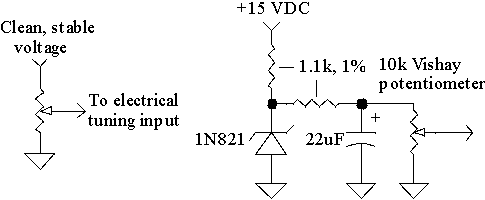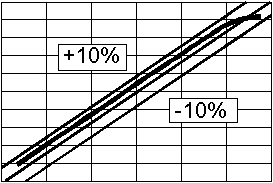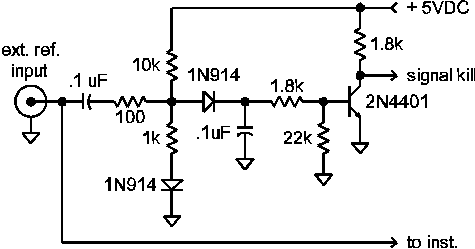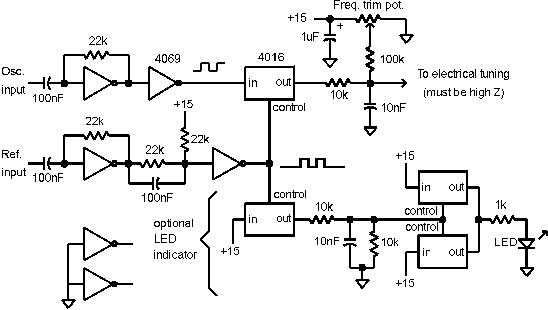Mechanical and/or electrical tuning provisions are provided with most crystal oscillators to adjust the frequency for phase-locking or modulation or to compensate for long-term drift. Mechanical tuning is often accomplished with a single or multi-turn trimmer capacitor or inductor in the crystal circuit which is accessed through a hole in the oscillator housing.
Most Wenzel Associates oscillators employ a varactor diode for all tuning and the mechanical tuning is accomplished internally with a precision potentiometer connected to a precision reference voltage. Our tests have shown that the mechanical stability and hysterisis of the highest quality trimmer potentiometers exceeds the stability of the best precision trimmer capacitors. Electrical tuning is accomplished with the same varactor diode in a configuration yielding high tuning linearity. The mechanical tuning voltage from the potentiometer is applied to the cathode of the tuning diode and the electrical tuning voltage is applied to the anode of the diode through a signal isolating network. The electrical tuning may be centered around zero volts so that in the absence of input the oscillator reverts to the mid-point of the electrical tuning.
As an option, the oscillator’s internal reference voltage may be brought out to a pin for connecting to a multi-turn potentiometer for fine tuning. Alternately, a clean DC derived from a separate supply may be applied to the electrical tuning pin. If the available supplies are noisy or unstable, it may be desirable to add a zener diode or reference device and a low-pass noise filter. A temperature compensated zener such as the 1N821 is an excellent choice giving good temperature stability and very low noise – in most instances the 22uF filter capacitor shown below may be left out. Reference devices exhibit excellent stability but they often have rather high noise voltage and the additional filtering is recommended.

Here are a few points to consider:

Many instruments employing precision crystal oscillators as an internal frequency reference have provisions for accepting an external reference as well. The selection of internal or external may be made by manually throwing a switch or it may be automatically triggered by the presence of signal at the external reference input connector. In the simplest of cases the manual switch simply selects which signal source to direct to the instrument and terminates the unused source with an appropriate resistor. When the internal reference is an oven oscillator, it is often desirable to have a “signal-kill” input to turn the oscillator off while leaving the oven operating. TCXOs and non-compensated oscillators may be turned off when the external reference is present to avoid potential interference.
Signal-kill inputs typically accept ordinary TTL levels but they may be configured for custom switching levels without difficulty. Most signal-kill inputs are designed to float to the “on” state when not connected and internal RC circuitry protects the oscillator from damaging voltages or interfering RF signals which might be present on the control line. The circuit shown below will detect the presence of an external reference greater than 1 volt p-p and generate a logic “low” suitable for driving most signal-kill inputs. This control signal could also be used to gate the external input to the instrument’s circuitry. The circuit is designed to exhibit a fairly high input impedance so proper cable termination is assumed elsewhere in the instrument.

If the internal oscillator is expected to have better short-term stability than the external reference it may be desirable to phase-lock the internal oscillator to the reference. The locked oscillator will exhibit the good short-term stability of the internal crystal oscillator and the good long-term stability of the external reference. A simple first-order loop may be made with a tri-state bus device or analog switch and a few additional parts. The basic concept is to drive the tri-state control with the external reference signal and pass the internal oscillator signal through one of the tri-stated gates so that the reference signal samples the internal oscillator signal. The output of the tri-state gate is low-pass filtered to remove the RF frequencies and connected to the electrical tuning of the internal oscillator. The tri-state control line is biased such that the gate output “floats” when the external reference is absent. This high-impedance state allows the tuning line to be pulled by a high-value resistor connected to a tuning potentiometer when no external reference is present. The 74HC244 has two sets of four tri-state buffers and is a good choice since the four gates not being used may be employed to buffer the signals.
The following circuit uses the same technique using only two CMOS devices, a 4069 hex inverter and a 4016 or 4066 analog switch. The frequency trimmer potentiometer controls the frequency when no reference is present. The circuit also includes an LED driver to indicate the presence of the external reference signal. Component values are not particularly critical and optimum values will depend upon the application.

The circuit as shown is a first-order loop with most precision oscillators. For example, a 10 MHz oven oscillator might have a tuning sensitivity of 1Hz per volt and, with a 15 volt supply, the phase slope is about 3 volts per radian. The bandwidth of the first-order loop is the product of the tuning sensitivity and the phase slope (1 Hz/volt x 3 volts/rad. = 3 Hz) which is well below the roll-off frequency of the 10k and 10nF network. If the oscillator has a much higher tuning sensitivity, the bandwidth will be proportionally higher and a second-order response may be desired to reduce external reference noise. Although the traditional lossy-integrator op-amp type-2 circuit could be added, additional provisions will be necessary to control the frequency in the absence of the reference since the integrator will tend to wander to one of the supply rails. An alternative way to achieve a second-order response while preserving the automatic tuning switchover is to add an additional passive filter. This type-1 second-order loop is easily achieved by adding a 100k or larger series resistor to the output. Another resistor in series with a capacitor is now added to ground at the output to add an additional roll-off. It may be tempting to simply increase the 10nF capacitor to achieve a lower bandwidth but the damping may become unacceptably low. In fact, if the oscillator has a very wide tuning range, the 10nF may be too large for sufficient damping. (In most reference applications, the first-order loop as shown is usually fine since phase error is not important and the lock bandwidth is not critical.)
Notes:
Also read about high-performance Type-2 loops featuring Ultra-Low Noise Oscillators.